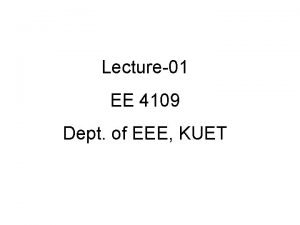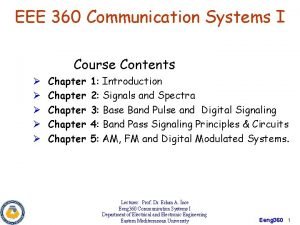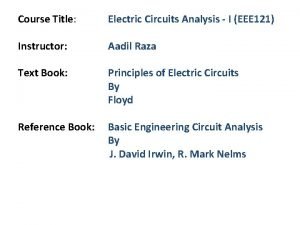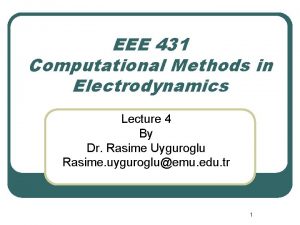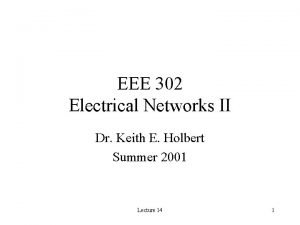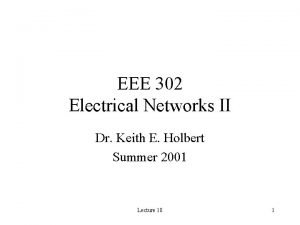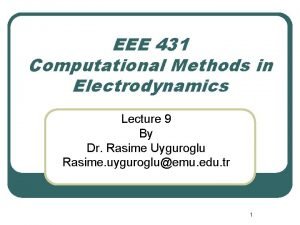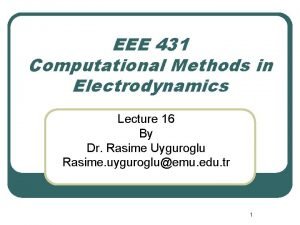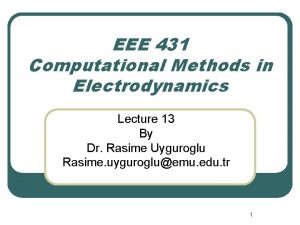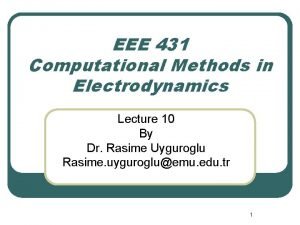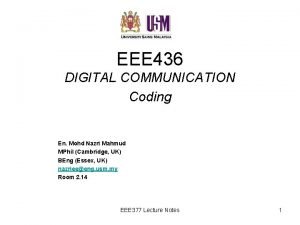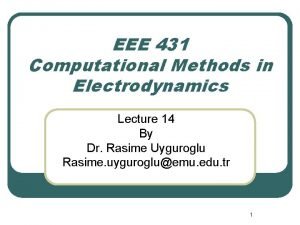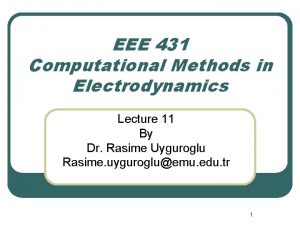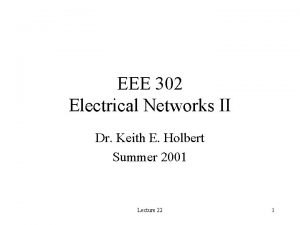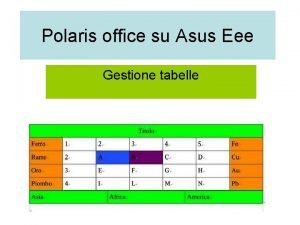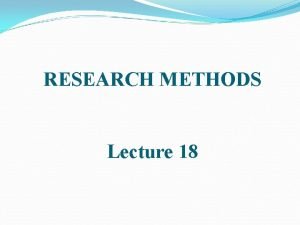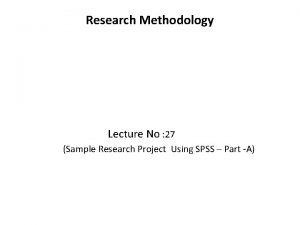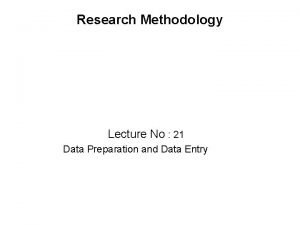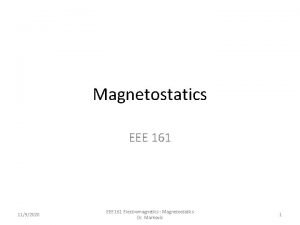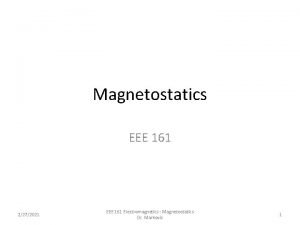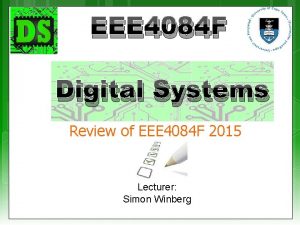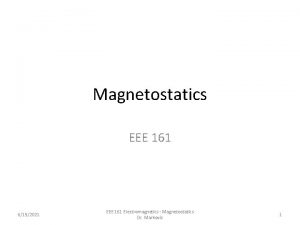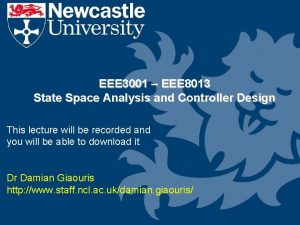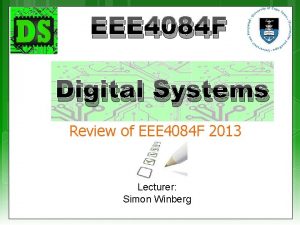Research Methodology Dr Unnikrishnan P C Professor EEE














































- Slides: 46

Research Methodology Dr. Unnikrishnan P. C. Professor, EEE

Module II q Tools and Techniques of Data Collection

Research Process Step V. Collect Data(Execution)

Collection of Secondary data means data that are already available i. e. , they refer to the data which have already been collected analysed by someone else. When the researcher utilises secondary data, then he has to look into various sources from where he can obtain them. In this case he is certainly not confronted with the problems that are usually associated with the collection of original data. Secondary data may either be published data or unpublished data.

Selection Secondary data Ø Reliability of data Ø Suitability of data Ø Adequacy of data

Case Study Method The case study method is a very popular form of qualitative analysis and involves a careful and complete observation of a social unit, be that unit a person, a family, an institution, a cultural group or even the entire community. It is a method of study in depth rather than breadth. The case study places more emphasis on the full analysis of a limited number of events or conditions and their interrelations. The case study deals with the processes that take place and their interrelationship. Thus, case study is essentially an intensive investigation of the particular unit under consideration. The object of the case study method is to locate the factors that account for the behavior -patterns of the given unit as an integrated totality.

Characteristics of the Case Study Method Ø Under this method the researcher can take one single social unit or more of such units for his study purpose. Ø Here the selected unit is studied intensively i. e. , it is studied in minute details. Ø In the context of this method we make complete study of the social unit covering all facets. Ø Under this method the approach happens to be qualitative and not quantitative. Ø Case study method results in fruitful hypotheses along with the data which may be helpful in testing them.

Assumptions in Case Study Method (i) The assumption of uniformity in the basic human nature in spite of the fact that human behavior may vary according to situations. (ii) The assumption of studying the natural history of the unit concerned. (iii) The assumption of comprehensive study of the unit concerned.

Phases of the Case Study Method (i) Recognition and determination of the status of the phenomenon to be investigated or the unit of attention. (ii) Collection of data, examination and history of the given phenomenon. (iii) Diagnosis and identification of causal factors as a basis for remedial or developmental treatment. (iv) Application of remedial measures (v) Follow-up programe to determine effectiveness of the treatment applied.

Steps of Data Preparation Process Ø Ø Ø Ø Questionnaire checking Editing Coding Classification Tabulation Graphical representation Data Cleaning Data Adjusting

Questionnaire checking This involves the examination of all questionnaires for their completeness and interviewing quality. Usually this step undertaken at the time of data collection. If questionnaires checking was not done at the time of data collection, it should be done later.

Questionnaire checking A questionnaire may not be acceptable if Ø It is incomplete partially or fully. Ø It is answered by a person who has inadequate knowledge or does not qualify for the participation. Ø It is answered in such a way which gives the impression that the respondent could not understand the question. If sufficient number of questionnaires are not accepted the researcher may like to collect more data

Editing of data is a process of examining the collected raw data (specially in surveys) to detect errors and omissions and to correct these when possible. As a matter of fact, editing involves a careful scrutiny of the completed questionnaires and/or schedules. Editing is done to assure that the data are accurate, consistent with other facts gathered, uniformly entered, as completed as possible and have been well arranged to facilitate coding and tabulation.

Editing –contd… Types of editing Field Editing Central Editing

Field Editing Field editing consists in the review of the reporting forms by the investigator for completing (translating or rewriting) what the latter has written in abbreviated and/or in illegible form at the time of recording the respondents’ responses. This type of editing is necessary in view of the fact that individual writing styles often can be difficult for others to decipher. This sort of editing should be done as soon as possible after the interview, preferably on the very day or on the next day.

Central Editing Central editing should take place when all forms or schedules have been completed and returned to the office. This type of editing implies that all forms should get a thorough editing by a single editor in a small study and by a team of editors in case of a large inquiry. Editor(s) may correct the obvious errors such as an entry in the wrong place, entry recorded in months when it should have been recorded in weeks, and the like. In case of inappropriate on missing replies, the editor can sometimes determine the proper answer by reviewing the other information in the schedule.

Points while performing Editing Ø They should be familiar with instructions given to the interviewers and coders as well as with the editing instructions supplied to them for the purpose. Ø While crossing out an original entry for one reason or another, they should just draw a single line on it so that the same may remain legible. Ø They must make entries (if any) on the form in some distinctive color and that too in a standardized form. Ø They should initial all answers which they change or supply. Ø Editor’s initials and the date of editing should be placed on each completed form or schedule.

Coding refers to the process of assigning numerals or other symbols to answers so that responses can be put into a limited number of categories or classes. Such classes should be appropriate to the research problem under consideration. They must also possess the characteristic of exhaustiveness (i. e. , there must be a class for every data item) and also that of mutual exclusively which means that a specific answer can be placed in one and only one cell in a given category set.

Coding-Contd… Coding is necessary for efficient analysis and through it the several replies may be reduced to a small number of classes which contain the critical information required for analysis. Coding decisions should usually be taken at the designing stage of the questionnaire. This makes it possible to pre-code the questionnaire choices and which in turn is helpful for computer tabulation as one can straight forward key punch from the original questionnaires.

Classification Simple classification – one attribute and divide the whole universe into two classes - example Teachers with Ph. D. Yes No Total 11 92 103 20

Classification Contd…. . Manifold classification – two or more attributes and divide data into a number of classes - example Qualification of bank officers Yes No Total Male Female Engg degree MBA 12 10 28 35 40 45 5 2 35 43 40 45 Engg+ MBA 2 1 38 44 40 45 21

Classification Contd…. . – Classification according to class intervals- done for data related to income, weight, height, age etc Weight of students in class A Range of weight 41 -50 kg 51 -60 kg 61 -70 kg Total Frequency 26 19 15 60 Percentage 44 31 25 100 22

Scaling of data Measurement is defined as process of associating numbers or symbols to observations obtained in a research study. These observations could be qualitative or quantitative.

Scaling of data –Contd… Ø Ø Nominal data Ordinal data (Mohs’ scale) Interval data Ratio data

Scale classification and Types Scales of measurement can be considered in terms of their mathematical properties. The most widely used classification of measurement scales are Ø Nominal scale Ø Ordinal scale Ø Interval scale Ø Ratio scale.

Nominal scale is simply a system of assigning number symbols to events in order to label them. The usual example of this is the assignment of numbers of basketball players in order to identify them. Such numbers cannot be considered to be associated with an ordered scale for their order is of no consequence; the numbers are just convenient labels for the particular class of events and as such have no quantitative value.

Nominal scale-Contd… Nominal scale is the least powerful level of measurement. It indicates no order or distance relationship and has no arithmetic origin. A nominal scale simply describes differences between things by assigning them to categories. Nominal data are, thus, counted data. The scale wastes any information that we may have about varying degrees of attitude, skills, understandings, etc.

Ordinal scale The lowest level of the ordered scale that is commonly used is the ordinal scale. The ordinal scale places events in order, but there is no attempt to make the intervals of the scale equal in terms of some rule. Rank orders represent ordinal scales and are frequently used in research relating to qualitative phenomena.

Ordinal scale-Contd… Thus, the use of an ordinal scale implies a statement of ‘greater than’ or ‘less than’ (an equality statement is also acceptable) without our being able to state how much greater or less. The real difference between ranks 1 and 2 may be more or less than the difference between ranks 5 and 6. Since the numbers of this scale have only a rank meaning, the appropriate measure of central tendency is the median.

Interval scale In the case of interval scale, the intervals are adjusted in terms of some rule that has been established as a basis for making the units equal. The units are equal only in so far as one accepts the assumptions on which the rule is based. Interval scales can have an arbitrary zero, but it is not possible to determine for them what may be called an absolute zero or the unique origin.

Interval scale-Contd… More powerful statistical measures can be used with interval scales. Mean is the appropriate measure of central tendency, while standard deviation is the most widely used measure of dispersion. Product moment correlation techniques are appropriate and the generally used tests for statistical significance are the ‘t’ test and ‘F’ test.

Ratio data Ratio scales have an absolute or true zero of measurement. The term ‘absolute zero’ is not as precise as it was once believed to be. We can conceive of an absolute zero of length and similarly we can conceive of an absolute zero of time. Ratio scale represents the actual amounts of variables. Measures of physical dimensions such as weight, height, distance, etc. are examples. Generally, all statistical techniques are usable with ratio scales and all manipulations that one can carry out with real numbers can also be carried out with ratio scale values.

Goodness of Measurement Scales A measurement scale has to have certain desirable qualities to judge their goodness in measuring the characteristics under study. Ø Validity Ø Reliability Ø Practicality Ø Accuracy

Goodness of Measurement Scales – Contd… Sound measurement must meet the tests of validity, reliability and practicality. In fact, these are three major considerations one should use in evaluating a measurement tool. “Validity refers to the extent to which a test measures what we actually wish to measure. Reliability has to do with the accuracy and precision of a measurement procedure. . . Practicality is concerned with a wide range of factors of economy, convenience, and interpretability. ”

Validity is the most critical criterion and indicates the degree to which an instrument measures what it is supposed to measure. Validity can also be thought of as utility. In other words, validity is the extent to which differences found with a measuring instrument reflect true differences among those being tested. Three types of validity (i) Content validity. (ii) Criterion-related validity. (iii) Construct validity.

Content validity is the extent to which a measuring instrument provides adequate coverage of the topic under study. If the instrument contains a representative sample of the universe, the content validity is good. Its determination is primarily judgmental and intuitive. It can also be determined by using a panel of persons who shall judge how well the measuring instrument meets the standards, but there is no numerical way to express it.

Criterion-related validity relates to our ability to predict some outcome or estimate the existence of some current condition. This form of validity reflects the success of measures used for some empirical estimating purpose. Criterion must possess the following qualities Relevance: (A criterion is relevant if it is defined in terms we judge to be the proper measure. ) Freedom from bias: (Freedom from bias is attained when the criterion gives each subject an equal opportunity to score well. )

Criterion-related validity-Contd. . Reliability: (A reliable criterion is stable or reproducible. ) Availability: (The information specified by the criterion must be available. ) Criterion-related validity is a broad term that actually refers to (i) Predictive validity (ii) Concurrent validity.

Construct validity is the most complex and abstract. A measure is said to possess construct validity to the degree that it confirms to predicted correlations with other theoretical propositions. Construct validity is the degree to which scores on a test can be accounted for by the explanatory constructs of a sound theory. For determining construct validity, we associate a set of other propositions with the results received from using our measurement instrument. If measurements on our devised scale correlate in a predicted way with these other propositions, we can conclude that there is some construct validity.

Reliability A measuring instrument is reliable if it provides consistent results. Reliable measuring instrument does contribute to validity, but a reliable instrument need not be a valid instrument. For instance, a scale that consistently overweighs objects by five kgs. , is a reliable scale, but it does not give a valid measure of weight. Two aspects of reliability 1. stability 2. equivalence

Reliability-Contd… Reliability can be improved in the following two ways: (i) By standardising the conditions under which the measurement takes place i. e. , we must ensure that external sources of variation such as boredom, fatigue, etc. , are minimised to the extent possible. (ii) By carefully designed directions for measurement with no variation from group to group, by using trained and motivated persons to conduct the research and also by broadening the sample of items used. This will improve equivalence aspect.

Reliability-Contd… The stability aspect is concerned with securing consistent results with repeated measurements of the same person and with the same instrument. We usually determine the degree of stability by comparing the results of repeated measurements. The equivalence aspect considers how much error may get introduced by different investigators or different samples of the items being studied. A good way to test for the equivalence of measurements by two investigators is to compare their observations of the same events.

Practicality The practicality characteristic of a measuring instrument can be judged in terms of economy, convenience and interpretability. From the operational point of view, the measuring instrument ought to be practical i. e. , it should be economical, convenient and interpretable. Economy consideration suggests that some tradeoff is needed between the ideal research project and that which the budget can afford.

Practicality-Contd… Convenience test suggests that the measuring instrument should be easy to administer. For this purpose one should give due attention to the proper layout of the measuring instrument. For instance, a questionnaire, with clear instructions (illustrated by examples), is certainly more effective and easier to complete than one which lacks these features. Interpretability consideration is specially important when persons other than the designers of the test are to interpret the results.

Accuracy The characteristics of accuracy of a measurement scale means it should be a true representative of the observation of underlying characteristic. For example, measuring with an ‘inch’ scale will provide accurate value only upto one-eighth of an inch, while measuring with ‘cm’scale will provide more accurate value.

 Promotion from assistant to associate professor
Promotion from assistant to associate professor Kuet eee
Kuet eee Eee 360
Eee 360 Ankara university
Ankara university Eee 121
Eee 121 Eee 431
Eee 431 Eee 302
Eee 302 Eee 302
Eee 302 Tahvel.edu.eee
Tahvel.edu.eee Eee 431
Eee 431 Eee 431
Eee 431 Eee 431
Eee 431 Eee 431
Eee 431 Eee 145
Eee 145 Eee
Eee Lempel-ziv coding in digital communication
Lempel-ziv coding in digital communication Eee 431
Eee 431 Eee 431
Eee 431 3 phase short circuit
3 phase short circuit Eee 302
Eee 302 Vectoral
Vectoral Eee
Eee ëëë
ëëë Eee
Eee Android (linux-based)
Android (linux-based) Hku eee lab
Hku eee lab Cute pdf
Cute pdf Diu eee faculty
Diu eee faculty String conversion
String conversion Eee components
Eee components Eee office
Eee office Eee office
Eee office Eee metu
Eee metu Eee components
Eee components Eee 202
Eee 202 Narrative report with contextual descriptions
Narrative report with contextual descriptions Problem statement objectives
Problem statement objectives What are variables in research methodology
What are variables in research methodology Objectives in research methodology
Objectives in research methodology Research methodology flow chart
Research methodology flow chart Steps of research proposal
Steps of research proposal Goodness of measurement scale
Goodness of measurement scale Four dimensions of research
Four dimensions of research Methodology vs research design
Methodology vs research design Theoretical background
Theoretical background Central editing in research methodology
Central editing in research methodology Research methodology lecture
Research methodology lecture

